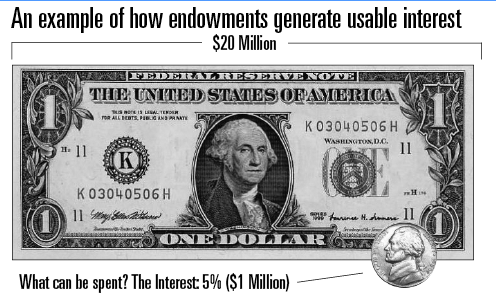Interest from endowment funds scholarship, aid

The $20 million dollar donation by the Mundays will produce $1 million of yearly student aid.
With the recent $20 million donation by the Munday family, the university endowment has risen to $76.8 million.
The university endowment is a large sum of money that is not meant to be spent itself. Rather, it gathers interest over time. This interest is what the university can spend.
If a dollar generates a nickel in yearly interest, for example, a dollar in a bank account would reliably generate nickels to spend every year. The university endowment operates along this analogy, Vice President of University Advancement Michael Larkin said.
“The endowment produces money every year, and there is a thing called the spending formula,” Larkin said. “Currently that is set to be five percent of a three year average. What does that mean? It means it’s not a strict five percent. The fact is this dollar over three years is probably slightly less than a dollar. “
Essentially, due to inflation in the economy, a dollar will be worth slightly less in three years than it is today.
“Every time somebody gives us a dollar in endowment, what we’re basically doing is we’re saying we’re going to take this dollar and we’re going to stick it in the bank and we’re never going to spend that dollar,” Larkin said. “We’re going to spend what comes off of it every year. And then we don’t have to get it from another source.”
As the university endowment climbs, it will generate more interest to spend.
Rhonda Cartwright, vice president of Financial Affairs, said the endowment contributes about .5 percent to the operating budget every year.
Peer Comparisons
The majority of the operating budget comes from tuition and fees.
“Over 90 percent of the operating budget revenue comes from tuition and fees. St. Edward’s current operating budget for 2013 is $146.6 million,” Cartwright said.
Compared to its peer universities, St. Edward’s endowment is smaller than most. Two of St. Edward’s peers are Southern Methodist University, SMU, and Baylor University., Cartwright said. SMU’s endowment in May 2012 was $1.16 billion. Baylor’s endowment at the end of May 2012 was $964 million.
The university’s small classes are the cause of both high tuition costs and the low endowment, Larkin said.
Small Class Sizes
“A university like St. Edward’s is a nonprofit organization. Unlike a business when you try to make money and give your profits back to shareholders, we’re just trying to not run at a deficit,” Larkin said. “Basically we’re just trying to make sure that we’ve got enough revenue to cover all the expenses.”
By far the largest expense is faculty salaries.
“People want to know why tuition is so high. Well, do you like your faculty? They have to be paid. That’s the biggest expense,” Larkin said. “UT’s tuition is less because their classes are huge. The smaller the classes are, the more people you need. You need more income. There’s a direct correlation between the tuition and what you spend the money on, and most of what tuition is spent on is things that benefit the students, which are the teachers, student services, Student Life, those things.”
The small classes result in a high faculty-to-student ratio, which explains the need for higher tuition. They also result in a comparatively low amount of graduates, which means less potential donors than a larger school.
“The endowment now is half the operating budget. That’s not ideal, but you have to balance that with the realistic: people have to give it to you. One of the challenges that St. Edward’s always had was that when you have small classes, you don’t get as many graduates … Unless you have a real good connection, it’s hard to get those dollars,” Larkin said.
Larger Endowment
Even if the endowment raises further, this does not mean tuition will necessarily be lower, Larkin said.
Harvard has an endowment in the neighborhood of $30 billion, according to Larkin. If Harvard followed St. Edward’s spending formula, it would generate $1.5 billion a year.
“I don’t know what Harvard’s budget is, but I do know that they charge tuition. So they made a conscious decision. You could run ten St. Edward’s Universities on the amount of money that’s being spun off from Harvard’s endowment. But they still charge tuition. The premise is, they’re going to give financial aid to people who can’t afford it. But if you can pay, they’re still going to make you pay something.”
A larger endowment will mean more financial aid and scholarships to give to students, but tuition is still required to pay faculty salary and university expenses.
However, just because a university has a large endowment does not mean it will have lower tuition, Larkin said.
“In fact it’s actually the opposite. And that is really counterintuitive,” Larkin said. “Because what it’s saying is when you have a big endowment, you’re pretty successful, so therefore you can charge people who are willing and capable of paying. But at the same time what you’re going to try to do is make it easier for people who can’t.”
Private Schools
Another reason why tuition so heavily funds the operating budget is that St. Edward’s is a private school.
Public schools such as UT receive tax dollars for financial aid, for example. A private school like St. Edward’s gets no such benefit.
“Often times when the national media presents articles, they don’t explain the fundamentals and distinctions, for example why state universities have lower tuition: bigger classes and public dollars from taxes,” Larkin said. Over time, the state has cut the money that it gives. So every year, you need more tuition, more endowment dollars, and more state money, but the states been cutting money, and the endowment has to grow significantly to produce anything.”
Additional reporting by Kristina Schenck and Katie Heim.






